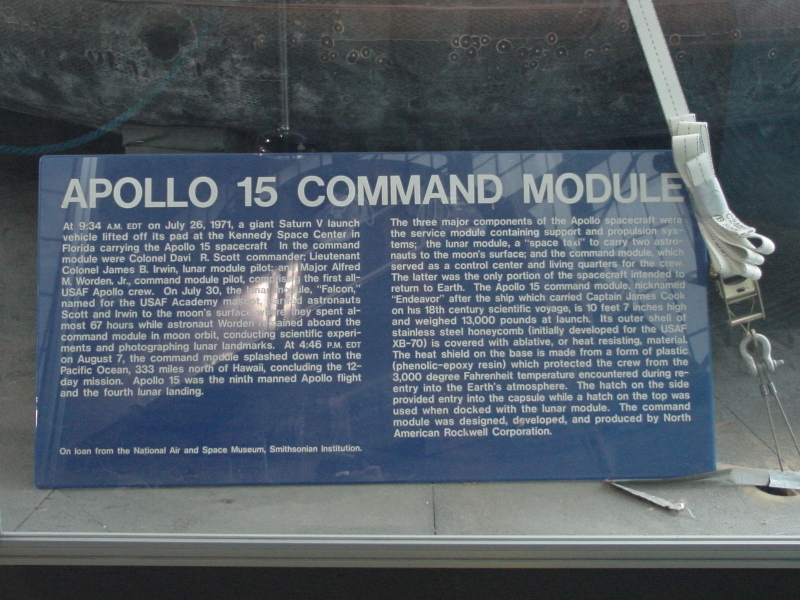| Prev |
heroicrelics.org Air Force Museum Site Index Apollo 15 (Presidential Hangar) Gallery |
Next |
dsc04362.jpg
One of the signs accompanying Apollo 15. It reads
Apollo 15 Command Module
At 9:34 A.M. EDT on July 26, 1971, a giant Saturn V launch vehicle lifted off its pad at the Kennedy Space Center in Florida carrying the Apollo 15 spacecraft. In the command module were Colonel David R. Scott, commander; Lieutenant Colonel James B. Irwin, lunar module pilot; and Major Alfred M. Worden, Jr., command module pilot, comprising the first all-USAF Apollo crew. On July 30, the lunar module, "Falcon," named for the USAF Academy mascot, carried astronauts Scott and Irwin to the moon's surface where they spent almost 67 hours while astronaut Worden remained aboard the command module in moon orbit, conducting scientific experiments and photographing lunar landmarks. At 4:46 P.M. EDT on August 7, the command module splashed down into the Pacific Ocean, 333 miles north of Hawaii, concluding the 12-day mission. Apollo 15 was the ninth manned Apollo flight and the fourth lunar landing.
The three major components of the Apollo spacecraft were the service module containing support and propulsion systems; the lunar module, a "space taxi" to carry two astronauts to the moon's surface; and the command module, which served as a control center and living quarters for the crew. The latter was the only portion of the spacecraft intended to return to Earth. The Apollo 15 command module, nicknamed "Endeavor" after the ship which carried Captain James Cook on his 18th century scientific voyage, is 10 feet 7 inches high and weighed 13,000 pounds at launch. Its outer shell of stainless steel honeycomb (initially developed for the USAF XB-70) is covered with ablative, or heat resisting, material. The heat shield on the base is made from a form of plastic (phenolic-epoxy resin) which protected the crew from the 3,000 degree Fahrenheit temperature encountered during re-entry into the Earth's atmosphere. The hatch on the side provided entry into the capsule while a hatch on the top was used when docked with the lunar module. The command module was designed, developed, and produced by North American Rockwell Corporation.
On loan from the National Air and Space Museum of the Smithsonian Institution.

| Time picture taken | Fri Oct 31 10:44:00 2003 |
| Location picture taken | Presidential Gallery Air Force Museum Dayton, OH |
| Prev | Apollo 15 (Presidential Hangar) Gallery | Next |